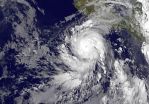Satellite sees Hurricane Blanca develop a pinhole eye
2015-06-03
(Press-News.org) Tropical Storm Blanca strengthened into a hurricane while remaining almost stationary and about 400 miles west of the west coast of Mexico on June 3. NASA's Terra satellite captured an image of Blanca before it strengthened, while NOAA's GOES-West satellite saw the strengthening storm develop a pinhole eye.
Satellite data indicate that Blanca continues to rapidly strengthen as a small eye has become apparent in infrared imagery from NOAA's GOES-West satellite during the early morning hours today, June 3.
Blanca hasn't moved much in the last day but has continued to strengthen and during the early morning (local time) on June 3, the storm reached hurricane strength. Because of Blanca's location and proximity to the coast, the National Hurricane Center cautions that swells generated by Blanca will begin affecting portions of the coast of southwestern Mexico during the next couple of days. These swells are likely to cause life-threatening surf and rip current conditions.
NOAA's GOES-West satellite provided an infrared look at Blanca today, June 3 at 1200 UTC (8 a.m. EDT), after it strengthened into a hurricane today. The GOES image showed that Blanca had a tiny 'pinhole" eye. Hurricane force winds extend outward up to 15 miles (30 km) from the center indicative of the tiny eye. Tropical storm force winds extend outward up to 90 miles (150 km). The estimated minimum central pressure is 964 millibars (28.47 inches).
At 5 a.m. EDT (0900 UTC), the center of Hurricane Blanca was located near latitude 12.6 North, longitude 104.7 West. That's about 410 miles (655 km) south-southwest of Zihuatanejo, Mexico and 445 miles (701 km) south of Manzanillo, Mexico. The National Hurricane Center noted that Blanca is nearly stationary and is expected to move very little through tonight. The hurricane is forecast to accelerate toward the north-northwest on Thursday.
Satellite data indicate that the maximum sustained winds have increased to near 110 mph (175 km/h) with higher gusts. Rapid strengthening is forecast to continue, and Blanca is expected to become a major hurricane later today.
NHC forecaster Daniel Brown noted in the 5 a.m. EDT, June 3 discussion, "Rapid intensification is forecast to continue during the next 24 hours while Blanca remains over very warm water and in a low shear environment."
The NHC forecast track takes Blanca on a northerly track and landfall on the southern tip of Baja California by Sunday, June 7 as a tropical storm. Residents of southern Baja California and mainland Mexico should begin preparations for Blanca's arrival over the weekend.
INFORMATION:
[Attachments] See images for this press release:


ELSE PRESS RELEASES FROM THIS DATE:
2015-06-03
When the scent of a fragrant product triggers a fond memory that a customer holds, it is more likely to be a hit. So says Rachel Herz of Brown University, and Haruko Sugiyama and colleagues at the Kao Corporation in Japan and the US, who conducted a study now published in Springer's journal Chemosensory Perception. Its results indicate how a product's scent often evokes personal emotional memories and influences its appeals to customers.
Herz and colleagues set out to test how odor-evoked memories influence customers' perceptions of a product, as this has never been ...
2015-06-03
As astronauts embark on increasingly ambitious space missions, scientists have to figure out how to keep them healthy for longer periods far from Earth. That entails assuring the air they breathe and the water they drink are safe -- not an easy task given their isolated locations. But scientists are now reporting in the ACS journal Analytical Chemistry a new method to monitor the quality of both in real time with one system.
Current options for testing air and water for contaminants, including microbes and radiation, require collecting samples and sending them back to ...
2015-06-03
New research finds that when viewing black-oriented entertainment television that evokes black stereotypes in its comedy, black audiences are more comfortable watching the programming among their black peers than among their white counterparts, and viewing conditions did not make any difference among whites. The study led by Omotayo Banjo, a University of Cincinnati assistant professor of communication, is published online in Journalism & Mass Communication Quarterly and will appear in the fall issue of the print publication.
The article states that "The study examined ...
2015-06-03
Since 2002, close to 300 drug candidates to treat Alzheimer's have run into clinical dead ends. But now, having learned from those failures, researchers are testing -- and retesting -- a batch of the most promising compounds designed to slow the disease's progression. An article in Chemical & Engineering News, the weekly newsmagazine of the American Chemical Society, describes what made this possible and what lies ahead.
Lisa M. Jarvis, a senior correspondent at C&EN, reports that just a few years ago, Alzheimer's research suffered from several high-profile setbacks. ...
2015-06-03
To visualize cancer throughout the body, physicians often turn to positron emission tomography (PET), which lights up areas that are metabolically active or growing, like tumors. Today in ACS Central Science, researchers report development of new PET probes composed of labeled antibody fragments that were tested in mice. These probes could someday be used to create targeted probes, giving doctors more information about tumors and how to treat them.
The most common PET imaging probe is a labeled sugar molecule called 18F-2-deoxyfluoroglucose (FDG). PET indicates those ...
2015-06-03
Women with obesity have a range of increased health risks in pregnancy, both for them and their babies, compared with those in the healthy weight category, according to a new systematic review of research by academics at the School of Nursing and Midwifery, Trinity College Dublin, the University of Gothenberg, and City University London.
The paper, which was published today in the international peer-reviewed journal Obesity Reviews, recommends women with obesity should lose weight before they become pregnant, and also highlights the current lack of support available ...
2015-06-03
Life without bright screens on our smart phones and TVs is hard to imagine. But in 20 years, one of the essential components of the liquid-crystal displays, or LCDs, that make many of our gadgets possible could disappear. To address the potential shortage of this component -- the element indium -- scientists report in the journal ACS Sustainable Chemistry & Engineering a new way to recover the valuable metal so it could be recycled.
Many consumer electronics from laptops to tablets contain thin films of indium tin-oxide that act as transparent conductive coatings in ...
2015-06-03
Montreal, June 3, 2015 -- For many, summer holidays mean hitting the highway -- but nothing puts a damper on a road trip like an accidental collision with a deer.
For Jochen Jaeger, a professor in Concordia University's Department of Geography, Planning and Environment, improving roadkill prevention is best approached through experimentation.
In a study recently published in the Journal of Environmental Management, Jaeger and a group of co-authors from international universities show that protecting animals from speeding vehicles doesn't have a one-size-fits-all solution. ...
2015-06-03
Decentralized partially observable Markov decision processes are a way to model autonomous robots' behavior in circumstances where neither their communication with each other nor their judgments about the outside world are perfect.
The problem with Dec-POMDPs (as they're abbreviated) is that they're as complicated as their name. They provide the most rigorous mathematical models of multiagent systems -- not just robots, but any autonomous networked devices --under uncertainty. But for all but the simplest cases, they've been prohibitively time-consuming to solve.
Last ...
2015-06-03
The first feeding study of tropical Australia's Irukandji box jellyfish has found that they actively fish. They attract larval fish by twitching their extended tentacles, highlighting their nematocyst clusters (stinging structures) and using them as lures.
It's an impressive feat by any standards, but particularly so for an animal that doesn't have a defined brain.
The laboratory-based study of Carukia barnesi, the tiny but deadly Irukandji jellyfish, was conducted at James Cook University (JCU) in Cairns, Australia, and has been published in the online journal PLOS ONE. ...
LAST 30 PRESS RELEASES:
[Press-News.org] Satellite sees Hurricane Blanca develop a pinhole eye


